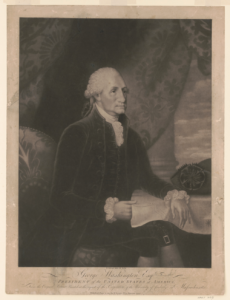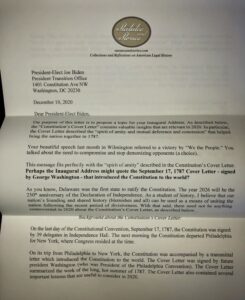A suggestion for Biden’s Inaugural Address – George Washington’s “spirt of amity” described in the Constitution’s Cover Letter
Following the November election, Statutesandstories.com began floating the suggestion that the Constitution’s “forgotten Cover Letter” might be a worthwhile topic for President Biden’s Inaugural Address. As described below, the Constitution’s September 17, 1787 Cover Letter contains valuable insights that might help unify the nation. In particular, the “spirit of amity” that helped animate the drafting of the Constitution in the summer of 1787 might serve as a model in 2021.
It has been reported that President Biden’s Inaugural Address will contain a “message of unity” and a “message of moving the country forward”. It will be interesting to see whether President Biden (or future presidents) will tap into the reservoir of good will and wisdom that the Constitution’s Cover letter might offer.
Copied below is the text of the open letter that was sent to the Biden transition team:
Dear President-Elect Biden:
The purpose of this letter is to propose a topic for your Inaugural Address. As described below, the “Constitution’s Cover Letter” contains valuable insights that are relevant in 2020. In particular, the Cover Letter described the “spirit of amity and mutual deference and concession” that helped bring the nation together in 1787.
Your beautiful speech in Wilmington referred to a victory by “We the People.” You talked about the need to compromise and stop demonizing opponents (a choice).
This message fits perfectly with the “spirit of amity” described in the Constitution’s Cover Letter. Perhaps the Inaugural Address might quote the September 17, 1787 Cover Letter – signed by George Washington – that introduced the Constitution to the world?
As you know, Delaware was the first state to ratify the Constitution. The year 2026 will be the 250th anniversary of the Declaration of Independence. As a student of history, I believe that our nation’s founding and shared history (blemishes and all) can be used as a means of uniting the nation following the recent period of divisiveness. With that said, there need not be anything controversial in 2020 about the Constitution’s Cover Letter, as described below.
Background about the Constitution’s Cover Letter:
On the last day of the Constitutional Convention, September 17, 1787, the Constitution was signed by 39 delegates in Independence Hall. The next morning the Constitution departed Philadelphia for New York, where Congress resided at the time.
On its trip from Philadelphia to New York, the Constitution was accompanied by a transmittal letter which introduced the Constitution to the world. The Cover Letter was signed by future president Washington (who was President of the Philadelphia Convention). The Cover Letter summarized the work of the long, hot summer of 1787. The Cover Letter also contained several important lessons that are useful to consider in 2020.
Among other things, the largely forgotten Cover Letter explained that the Constitution was the “result of a spirit of amity and mutual deference and concession” which some would argue has become a rare commodity today. The Cover Letter also touched on foundational principles including checks and balances and Locke’s social contract theory.
Historians generally assume that the Cover Letter was written by Gouverneur Morris, the “Penman” of the Constitution who wrote the Preamble. It is likely that Alexander Hamilton also assisted Morris write the Cover Letter. Note that according to President Abraham Lincoln, Gouverneur Morris, Ben Franklin and Alexander Hamilton were the most ardent opponents of slavery at the Philadelphia Convention.
The Cover Letter ends with the “most ardent wish” that the proposed Constitution would “promote the lasting welfare of that country so dear to us all and secure her freedom and happiness…” The Cover Letter successfully launched the ratification campaign. It was printed in newspapers around the nation in 1787-1788. The rest is history.
If we had the original copy signed by Washington, it would have a claim to be showcased in the National Archives alongside the Constitution and Bill of Rights. Alas we only have printed copies and a working draft (which is held by the Library of Congress with the records of the Constitutional Convention and Madison’s notes).
The Cover Letter is described in more detail in the following blog posts: https://www.statutesandstories.com/blog_html/who-knew-the-constitution-had-a-cover-letter/
https://www.statutesandstories.com/blog_html/the-legacy-of-the-constitutions-cover-letter-part- 3/
Here are other links that might be of interest:
Center for the Study of the American Constitution: https://csac.history.wisc.edu/2020/09/13/covering-the-constitution/
National Constitution Center: https://blog.consource.org/post/37657114075/civicfriendshipatconvention
The attack on the Capitol on January 6 is unprecedented in American history. Nevertheless, other famous Inauguration Addresses have attempted to invoke a message of unity.
Following the Revolution of 1800, the Adams-Jefferson transition became the first example of a peaceful transfer of power in modern history. In his Inaugural Address of March 4, 1801 President Jefferson famously remarked:
Let us then, fellow citizens, unite with one heart and one mind…We have called by different names brethren of the same principle. We are all Republicans, we are all Federalists…Let us, then, with courage and confidence pursue our own Federal and Republican principles, our attachment to union and representative government.
In March of 1861, President Lincoln was confronted with the secession of 7 (soon to increase to 11) Confederate states. A month before the Civil War would begin, Lincoln’s Inaugural Address appealed to the “better angels of our nature.” Tragically, Lincoln’s poetic invocation of the “mystic chords of memory…that swell the chorus of the Union” was unsuccessful in saving the lives of 620,000 Americans who would perish in American’s most bloody conflict:
We are not enemies, but friends. We must not be enemies. Though passion may have strained it must not break our bonds of affection. The mystic chords of memory, stretching from every battlefield and patriot grave to every living heart and hearthstone all over this broad land, will yet swell the chorus of the Union, when again touched, as surely they will be, by the better angels of our nature.
Last year during Covid quarantine, StatutesandStories prepared a four-part series of blog posts in an effort to re-discover the lessons that can be gained from the Constitution’s Cover Letter. Part 1 discussed the background behind the Cover Letter. Part 2 explored the “Alexander Hamilton Authorship Thesis.” Part 3 examined the legacy of the Cover Letter over time. Part 4 identified additional topics for further historic research.

